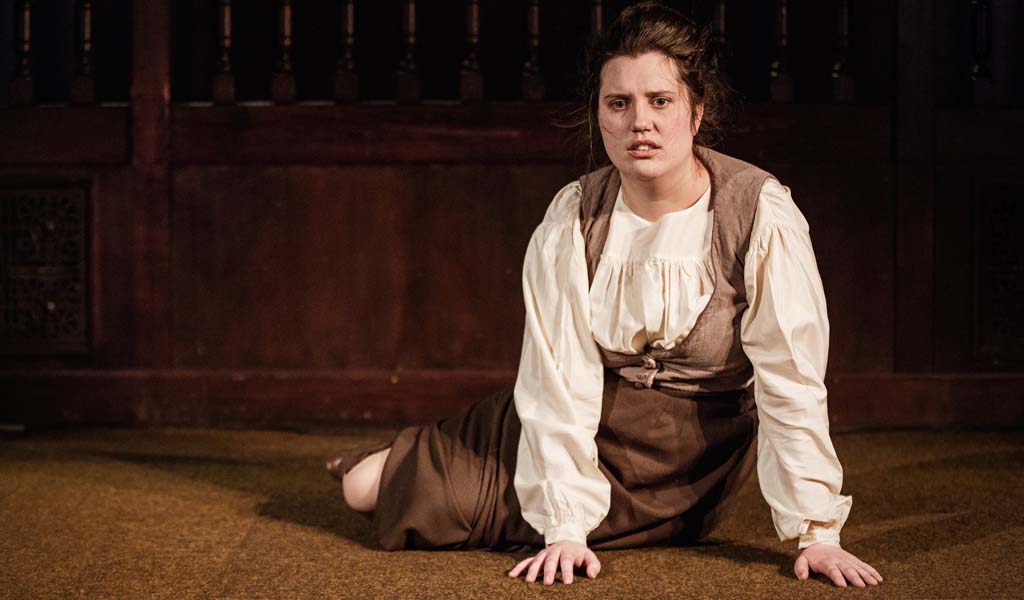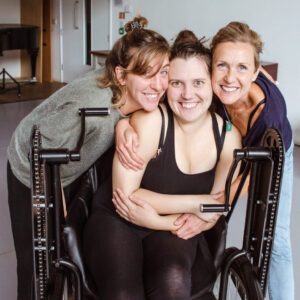
The Making of May
Powerful, one-woman show, MAY, is coming to The Courtyard stage in November, and we would love for more people to experience this unheard story. Find out more about the process of creating and producing this moving piece of theatre in this blog, from writer and performer Phoebe Kemp, and directors Rachel Adams and Anna Carr.

(Left to right) Anna Carr, Phoebe Kemp, Rachel Adams
Here’s Hattie (Wyldwood Marketing Assistant) in conversation with the team.
HT: So, Phoebe, how did you come up with the idea of creating this show?
PK: I had wanted for a long time to create a one-woman show about a historical disabled woman. I started looking in local archives but couldn’t find anyone – you can’t search disability! Then a Facebook article popped up about Rosa May Billinghurst, and as soon as I saw it, I knew that was who I was looking for.
HT: That sounds like a really special moment, to find that inspiration. So, Rachel and Anna, how did you get involved in the show?
AC: Phoebe and I first met at East 15 Drama school, and hadn’t been in touch since we graduated in 2011. When I saw that she’d started developing MAY I was a mixture of inspired and proud and knew I wanted to support its journey. I feel lucky to have been so involved with its development since October last year.
RA: Phoebe asked me to produce May back in 2017. The nature of the piece offering a platform to unheard voices inspired me to bring it under the banner of Wyldwood Arts and it has been growing steadily since. Initially the creative team, alongside Phoebe, was director Hannah Treadaway, and designer Natalie Remington – who has since become the producer. We also had the pleasure of working with director Alison Farina on the second tour as well. It’s been a great privilege to work with Phoebe to watch her develop as a performer and see the show grow and develop with each phase.
HT: So, you have been working on the project since 2017? Where has the show been so far?
RA: As with all new projects, it has taken awhile for funding to come to fruition which led to us creating a series of short tours initially around the South West, heading further afield to Cambridge and Newcastle for International Women’s Day this year, Artlink in Hull and a short run in London. This last tour has taken the show to Theatre By The Lake in Cumbria and we will be at Dorchester Arts and The Courtyard, Hereford in November.
Has the show changed since you first performed it? How?
RA: Yes! Working with different people has really enabled the show to be opened up to lots of creative voices and perspectives. This is especially important when working on a one-woman show because it’s so focused on the central character. Inviting people to be part of the process has enabled us to keep the show fresh.
PK: It has changed a lot. The first performance was lighter in tone and stylistically very different. I played all the characters and multi-roled, switching between them…
AC: … all of May’s friends and family, in caricature, like a family farce that moved from past to present.
PK: … where as now I just play May, as we wanted the focus to be on her story.
AC: It’s been like cutting away at a piece of fabric to find the right shape of it- and I think we’ve found it. In the second phase of development, our quest was to find May’s voice and character, against a historical backdrop of the suffragette struggle to tell the story.
We set it in the Victorian era, with old wooden ladders and a washing line, and explored music-hall music as an accompaniment, and even brought in a live amateur choir for our opening performance. It was magical hearing them rehearse ‘March for the Dawn’ in the courtroom at Trowbridge Town Hall. I’ll never forget a significant moment in rehearsal when Phoebe explained that her own relationship with her wheelchair gives her freedom. I think it was at that moment that the show changed to become what it is now.
We’ve boiled down all the important themes and ideas and discovered that the most essential relationship is between May and Franky. It’s become a timeless, stripped down approach born out of our desire to communicate the essence of the story to the audience in the most raw, authentic and direct way.
So, this is a solo performance, but who is Franky?
AC: Franky is short for Cranky Franky. Cranky Franky is the name of the wheelchair brand, from the 1930s, and a very similar model to the one that Rosa May Billinghurst was seen in. When Phoebe was looking for a replica model, she was in touch with a Paralympian, Sarah Piercy, who has a collection of old historical vintage wheelchairs and always called the one Phoebe borrowed from her Franky, so the name stuck.
RA: And recently, thanks to the creative challenge of adapting to traverse staging at Theatre by the Lake in Cumbria, we discovered how powerful the performance could be when shifted slightly to become more immersive for the audience. Phoebe, you said you found the experience immensely powerful, and the response from the audience also clearly had a huge impact.
PK: Yes, they actually gasped when I came back on stage for the Q&A in my actual wheelchair – surprised that I was a disabled person in “real life”.
RA: So we’ve now decided to keep the staging as traverse and explore the interaction between Phoebe and the audience further. We’ve also stripped back the set and costume to truly allow the strength of Phoebe’s writing and the narrative of May to be heard even more strongly.
What’s been the most interesting discovery whilst making this play?
PK: That May’s father took her to Bermuda because he wanted her to see the world!
RA: The biggest realisation for me is that Disabled people are so under-represented on stage, or in our history books – when you situate May in a present day context, it’s shocking to see how little progress has been made – we still live in a very “ableist” society. Once your eyes have been opened to the lack of opportunities and barriers people with disabilities face, it’s incredibly hard to not see how society disables people (further).
Representation on stage is absolutely vital if we are to change social attitudes towards people with disabilities. As theatre makers, and audiences, we have a responsibility to discourage “cripping up” and to include the voices of Disabled people when we represent the community on stage in a meaningful and authentic way.
Phoebe, what’s your favourite thing about portraying May Billinghurst?
PK: It’s hard to choose just one thing. Probably the intensity of emotions and her passion. It’s a great experience as an actor to go to those extremes.
And finally, Rachel, what is next for MAY?
RA: We’ve been so fortunate to have toured May to an audience of nearly 400 so far. Considering we are fairly new to producing, with a new show about a relatively unknown person from history, I think we’ve done incredibly well.
It feels like we are at a stage where we have the shape of a really powerful show. It‘s very exciting to gain more audience responses so we are aiming to take May to Edinburgh next year. This is no small feat and we will need to source lots of funding, access support and the right team to make it happen. But if May Billinghurst has taught us anything – it’s that anything is possible, no matter what adversities you face. And we believe that this show has a powerful message that supports equality for all.
Don’t miss May at The Courtyard this autumn. Book tickets online today for Friday 8 November.

